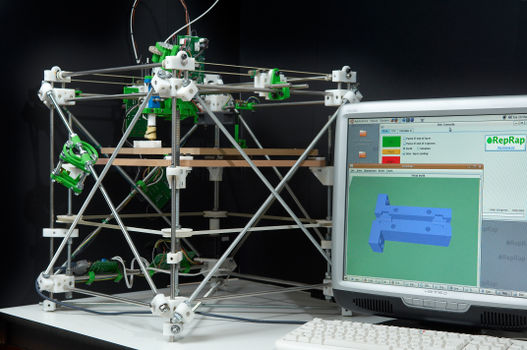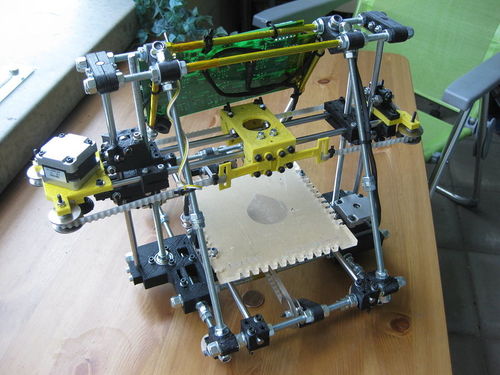RepRap is either a project (movement?), a community or a robot, depending on context. The project is the creation of Professor Adrian Bowyer of the University of Bath (UK) who, in a Keynote Address on the RepRap project in June 2006, set out the goals of developing replicating rapid prototypers: machines that could replicate themselves.
More precisely, RepRaps had to be able to manufacture a substantial percentage of their own parts (built on Open Source designs, licensed for free under the GNU General Public License) and the other necessary components should be standard hardware that is readily available to most folks. He was not so ambitious or idealistic as to think that they’d need to be able to assemble themselves also, so that is where we, humans (or RepRap symbionts), come in. If the machines perform useful tasks for us, we’ll help them to self replicate. And so began a movement.

The Mad Professor’s genius was in understanding the project to be social, biological, economic and technological and it is surely the balancing of the various constraints, demands, inputs and outputs that has allowed it to catch on and grow beyond its creator’s control, just as he envisioned.
Surely by this point you’re saying to yourself, “Has not one of these suicidal nerds seen the Terminator movies?” Is it really smart to make machines that can self-replicate? One possible answer is, “How can we not?” If the history of technological advancement has a single lesson for us, it might be that if we are capable of doing such a thing, we will (whether that means building atomic bombs or cloning animals). And if that is true, then having someone intelligently lay out the plan for such a thing ahead of time may not be the worst way to go. The future is always scary (more on this later) but we can’t stop it.

The first RepRap (we’re talking about the machine here) was the Darwin which was completed near the end of 2007 and successfully self-replicated around May of 2008 (before that all Darwin and Darwin derivatives were build with parts sourced from Statasys machines or from laser cut plywood frames, a building material still common to ReRaps kits).

During the summer of 2009 an improved RepRap Mendel was introduced and shortly therafter the Makerbot Cupcake was also introduced, the first real commercial product of the RepRap movement, a forking of the project that was surely unavoidable but did not come without much wailing and gnashing of teeth. (It may not be a coincidence that the Fused Deposition Modeling (a term for which they still own the trademark) patent held by Stratasys that many considered to be the most relevant to basic functionality of RepRaps expired in September of 2009.) The would be entrepreneurs at Makerbot (and other companies), having gained much from their association with the idealistic community but believing that a certain amount of closed source development would be required to establish a viable business model; and some of the RepRap true believers feeling betrayed and/or used. The debate continues to this day, made all the more challenging because of the murky state of copyright and patent protection where easily transferable 3d object designs are concerned.

RepRap development increased somewhat exponentially around this time with the Prusa Mendel becoming the RepRap of choice for larger build volumes and the Huxley being its smaller footprint cousin (it is not an accident that RepRaps are named after famous biologists). To keep up with the development and differentiation at this point would be a full time job unto itself, but the RepRap wiki has done an admirable job here.

The way the RepRap evolution continues to this day goes something like this. Person gets interested and decides to build a RepRap. He or she finds someone to print parts for them and sources the other hardware themselves, buys a kit with everything included or some combination of these things. He/she makes connections within the community through the process of researching, sourcing parts and seeking help with constructing their RepRap. He/she has some great ideas about how to improve the design and either builds it him or herself or shares the idea with the community at large or both. Evolution.
Our sense of self is completely informed by our history. The collection of experiences that is our life constructs an outward looking self-defense mechanism along the way called an ego, and for the most part, that is what we are on a day to day basis (moments of blissful transcendence aside). The future however is necessarily uncertain, and is in some way always killing this fragile ego that is only made up of the past. So when it looks like the future is a dystopia of certain death at every turn, well, as far as the ego is concerned, it kind of is. We cannot progress (evolve, make advancements or in the extremes even continue to exist) without learning and we cannot learn without unlearning something else, and this disassembly of our past experiences and lessons that no longer serve us can be painful, frightening or downright apocalyptic (if all you are is an ego that is).

So don’t be frightened at the prospect of becoming a symbiont for a newly evolving technological species. Maybe just as these RepRaps help us to construct new and wonderful things (and most critically: more RepRaps, let’s not forget the point here), they can also help us deconstruct our perpetually-former selves along the way.
One thought on “what the frak is a RepRap? (THE FUTURE IS OUR DOOM)”